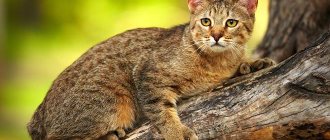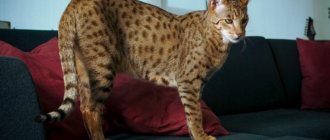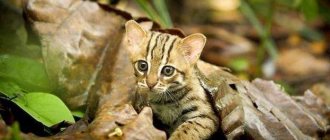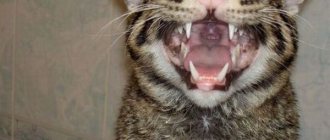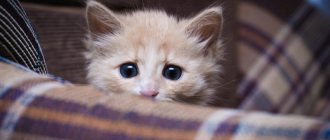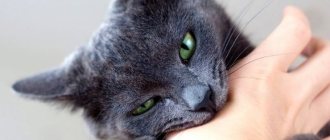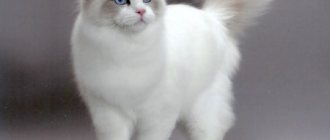Origin story
The birthplace of the pixie bob is the USA. In the spring of 1985, in the Washington area, felinologist Carol Ann Brewer bought an unusual kitten: he had an unusual number of toes (polydactyly) and a short bob tail. A year later, the American woman saved another short-tailed cat. He was very large: almost as tall as a man’s knees and weighing 8 kg (and this despite his emaciated state). In size it can compete with Maine Coons.
From the mating of these two unique cats, a girl kitten was born, who became the ancestor of a new breed. She was named Pixie, which means "elf". It was covered with dark spots against a faun-colored background with a red tint. Pixie's muzzle was very similar to a lynx. A year later, Brewer began a program to breed a new breed of pixie bob.
Description of appearance
Even in the photo, the pixie-bob impresses with its powerful physique and impressive size.
- These are large cats with a strong and muscular build. They have a powerful, wide chest and a flat back with slightly protruding shoulder blades. There is a small fold of skin on the belly of cats.
- These animals can compete in weight and size with the Maine Coon cat breed, since the weight of adult individuals can reach from eight to ten kilograms. Interestingly, cats of this breed have especially pronounced sexual dimorphism, and females differ from males not only in their smaller size, but also in lighter weight, not exceeding five to six kilograms.
- The pixie bob cat has long and strong paws with wide, rounded pads. A distinctive feature of these animals is polydactyly, and many representatives of this breed have six or seven fingers. The hind legs are noticeably longer than the front legs.
- The tail of cats of this breed is short and straight, sometimes with slight kinks and bends.
- What distinguishes these animals from other short-tailed cats, in particular from the American Bobtail, is the unusual shape of the head. The head of mini-lynxes is not wedge-shaped, but pear-shaped. Another distinctive feature of these cats is the presence of whiskers, which makes these animals even more similar to a lynx.
- The nose is small and straight.
- Cats have small, widely spaced ears. There are fluffy tassels on the rounded tips of the ears.
- The eyes of mini-lynxes are large, oval-shaped and deep-set. Pixie bob kittens are always born with blue or light blue eyes, but as they mature their eyes become green, yellow or amber in color.
- Among these cats there are representatives with both long and short hair. Their fur is thick, soft and silky. The fur on the belly is fluffier than on the rest of the body.
- The color of mini-lynxes can be brown, red or gray. All over the cat's body there are spots and stripes that are darker in color than the main color. The fur on the belly, chest and inside of the paws is slightly lighter than on the back.
Description of pixibobs
The TICA standard provides a clear description of all the features and characteristics of Pixie Bob cats.
The head should be shaped like an inverted pear. Head size varies from medium to large. The muzzle with a powerful chin looks broad and full, resembling an equilateral diamond. The whisker pads are round and fleshy, and the sideburns give the appearance of a lynx.
The wide ears are not particularly high, with a deep set and a slight tilt forward. The tips of the ears are rounded, ideal if there are tassels on them. A pale imprint is visible on the outside of the ear.
Deep-set eyes can be compared to a medium-sized, streamlined triangle. The eyelids look heavy. Kittens are born with blue eyes, and by the age of 7 months they resemble gooseberries in color. Bright green shades are less common.
The nose should have a slight hump and be slightly convex.
The pixie bob breed boasts a powerful body with prominent shoulder blades. The shoulders are located below the line of the middle-width protruding hips. The chest is strong, wide, the stomach sags.
global $ads_google; //data-ad-slot=”2475549904″ $ads_google = empty($ads_google) ? false : true; ?> if ($ads_google == false) {?> $ads_google = true; ?> } ?>
The cat steps with long, muscular paws. The forelimbs are shorter than the hind limbs. Genetic polydactyly allows for more than 8 digits, although the exhibition variant dictates up to 7 digits. There are also mitten paws, similar to a human hand.
A cat's tail has its own length requirements for show exhibitions: from 5 cm to the hock joint of an outstretched paw. Pet class flaunts any length. The ideal short-tailed pixie bob tail should be articulated and have curves and creases.
There are two varieties of the breed: some of its representatives are semi-longhaired, while others belong to the shorthaired group. What both groups have in common is long hair on the belly, something similar is seen in the Kurilian Bobtail.
The cat is not hypoallergenic; this should be taken into account when purchasing an animal.
All shades of spotted brown tabby color are acceptable.
Dimensions and weight of pixie bob
Pixie Bob cats can be either medium or large in size. The weight of males in adulthood reaches 5-7 kg, but you can find a large domestic specimen that weighs all of 12 kg. Females are smaller in size, weight and length: only 3-5 kg.
The growth of pets by 12 months can reach 30-35 cm, although some individual representatives reach this mark only by 4 years.
Pixiebob weight table by month
| Age | Female | Male |
| 1 month | 360-830 gr | 540-960 gr |
| 2 months | 810-1400 gr | 1.1-1.9 kg |
| 3 months | 1.4-2.4 kg | 2-3.1 kg |
| 4 months | 1.8-3.2 kg | 2.4-3.7 kg |
| 5 months | 2-3.5 kg | 2.8-4.1 kg |
| 6 months | 2.1-3.7 kg | 3.2-4.5 kg |
| 8 months | 2.3-4.1 kg | 3.7-5.2 kg |
| 10 months | 2.5-4.5 kg | 4.2-5.9 kg |
| 1 year | 2.7-4.8 kg | 4.6-6.5 kg |
| 2 years | 3-5 kg | 5-7 kg |
Character
The wild appearance of the pixie bob does not reflect the character of the breed - loving, trusting, gentle. And although it largely depends on the specific animal, in general these cats are smart, easy-going, love people and are active.
In general, breeders say that pixiebobs are attached to the whole family, and can find a common language with each member. They usually don't choose just one. Some cats get along well even with strangers, although others may hide under the sofa at the sight of strangers.
Most people love to spend time with their family and follow their owners around. They get along well with children and love to play with them, provided they are gentle with them. However, they also get along well with other cats and friendly dogs. They understand words and phrases very well, and when you mention a veterinarian, you can search for your cat for a long time...
Quite quiet, pixiebobs communicate not by meowing (some do not meow at all), but by making a variety of sounds.
Care
The Pixiebob cat breed is easy to keep and does not require special care. To avoid heavy shedding, you can brush your pet with a special brush. However, the procedure is not mandatory. Cats shed twice a year – in autumn and spring. They bathe pixiebobs every month.
Particular attention is paid to individuals with polydactyls. These cats often have overgrown claws. To prevent such a problem, the owner must regularly trim the claws of his ward. The procedure must be performed once every 2 weeks.
Representatives of this breed are very energetic and active. Just like dogs, they need exercise. This pet needs attention.
- Dog's sense of smell
- Maine Coon
- Domestic iguana
- How much does a raccoon cost?
- Interesting facts about cats
- Cute dog breeds
Pixiebobs are quite large cats; they feel comfortable only in a spacious room. Therefore, it is recommended to have them in a country house or in a large apartment.
Character and disposition
External resemblance to a related predator does not at all affect the character of the pixie bob. Cats are naturally endowed with high intelligence, good-natured character, gullibility, and devotion. Breeders highlight several traits inherent in representatives of the breed:
Friendliness
. Cats are friendly towards all family members and especially adore children. They enjoy participating in active games, but show due patience. They are ready to patiently endure the attacks of their little masters and will never hurt them. By leaving children in the company of a pixie-bob, you can be sure that the company will spend time in play and safety.
Devotion
. Cats are more famous for their arrogant and stubborn nature, but this is not the case with the pixie bob. The pet tries to spend more time near the owner, monitors his every action, accompanies him, but at the same time is completely unobtrusive. Pixiebob does not know what aggression and vindictiveness are. In their loyalty to their owner, these cats are similar to dogs. A curious feature of the breed is the ability to growl and make guttural sounds.
Addicted to attention, cannot stand loneliness. They fawn on their owner, strive to be constantly near him, and adore affection.
Cats are very smart
. They easily get used to the tray, master the skills and rules of life. They understand the owner’s speech and realize if he curses or praises. The short-tailed cat can be taught various techniques and funny tricks.
They love walks in the fresh air. Constantly being in a confined space is akin to imprisonment for them; without walks, they begin to mope. For regular walking, breeders use leashes; pets do not mind this.
Cats understand human speech and respond to calls to them with a growl or guttural speech. They are sociable by nature, inquisitive, sociable. Despite their frowning appearance and thick eyebrows, pixie-bobs are affectionate and good-natured pets.
Care
Representatives of the suit are unpretentious in everyday life. They calmly perceive heat or cold. This unpretentiousness is partly due to its origin from the wild lynx.
Pixiebobs love walks in the fresh air, allowing them to wear a collar. They do not perceive long-term confinement within four walls well, they begin to mope, and fall into melancholy. Walking should be done regularly, at least every other day.
Recommendations for caring for pixie bob are not original. Basic actions:
- keep the litter box clean;
- provide clean utensils for meals;
- comb the coat with a special brush once a week;
- wash your eyes, clean your ears;
- wash 6-7 times a year;
- Trim nails regularly.
Cats traditionally do not like to bathe, even if their ancestor is a wild animal. You need to prepare for the washing procedure by purchasing shampoo, a cap for the ears, and a large towel at the pet store. Frequent washing is caused by regular walks outside. If the cat is a show cat, then when going out in public it is allowed to use pet cosmetics to make the coat silky, shiny and rich in color. It is enough to use shampoo twice a year; in other cases, simply rinse the cat in water at room temperature without soap and water.
The hair is not prone to tangling and forming tangles. Therefore, your pet's fur does not require special care. It is enough to comb it periodically, especially since the cat loves this procedure. Combing removes fallen hairs and dead skin particles.
The seventh toe is vestigial and immobile. Breeders recommend cleaning the space between the sixth and seventh toes, where dirt and fat accumulate.
Nutrition
When organizing meals, you need to take into account the constitutional characteristics of your pet:
- large sizes;
- developed muscles.
To maintain your pet’s health, you need to feed it food rich in proteins, fats, carbohydrates, valuable microelements, and vitamins. Dry food cannot fully provide your pet with a complex of nutrients. Poultry meat must be included in the diet.
The pixie bob is unpretentious when it comes to food and eats both dry food and raw meat with equal pleasure. Diet diversity is the responsibility of the owner. A short-tailed cat demonstrates hunting skills and, while walking in its “patrimony”, can easily catch a bird or a mouse and eat it.
If you are planning a trip, it is not recommended to feed the animal before the trip. On the road, you need to take a bowl and a container with clean water for drinking. Pixie bob kittens eat raw, finely ground meat well. For good digestion, it is better to choose low-fat varieties. The meat is chopped and mixed with boiled porridge in a 3:1 ratio. Once a week, a boiled egg, low-fat cottage cheese, fish, and seafood are introduced into the diet. Be sure to add fresh herbs, soaked bread, and oil mixtures of vitamins to your food. Kittens need to be fed up to six times a day.
Animals quickly gain excess weight, which can cause various health problems. For this reason, it is unacceptable to overfeed your pet, treat it with treats from the owner’s table, include too fatty foods in the diet, or use flavoring additives. The serving size should be appropriate for the age and activity level of the cat.
Health
Nature has awarded short-tailed pixiebobs with good health and strong immunity. On average, cats live up to 13 years or longer. According to observations of the breed, no genetic diseases appeared. However, over 35 years of breeding pixie bobs, there were malfunctions in the reproductive system and hypertrophic cardiomyopathy. To determine whether a kitten has a predisposition to these diseases, it is necessary to check the health of the parents and do regular ultrasounds to check the functioning of the organs.
Pixibobs react to some vaccinations, so vaccination should be done after consultation with a veterinarian and under his full supervision. You can judge your pet's health by the weight of your pet. If it differs from the normal value, it means the animal is sick.
The main rule in maintaining health applies to all living beings, including humans. At the first signs of the disease, you should not self-medicate. Only a doctor can perform an examination and prescribe medications.
Price per kitten
The cost of a kitten is high, this is caused by several determining factors:
- difficult export outside North America;
- a small number of kittens in a litter of the same birth, difficulty in breeding.
The average price of one short-tailed kitten is 70,000 rubles. If the future owner does not plan to take the pet to exhibitions and agrees to take a kitten with disqualifying defects, then the price will be significantly lower.
For exhibition purposes, kittens are selected from specialized nurseries. In terms of external appearance, the animals fully comply with the standards of world associations of felinologists. Documents are drawn up for the kitten confirming its involvement in the declared breed: veterinary passport, metric (pedigree), vaccination card. Honest breeders do not change the price of a kitten depending on the presence or absence of documents. Documents are processed for the entire litter at the same time. In principle, there cannot be kittens “without paperwork” in specialized nurseries. The information in the documents allows you to find the breeder, ask him for advice on the contents, and sometimes even make a return.
The veterinary passport contains information about the kitten's breed, its name, gender, date of birth, names of parents, name of the breeder, information about vaccinations with a veterinary clinic stamp.
The veterinary passport in itself does not confirm the breed, because it is only a document about the characteristics of the animal, its physical and mental health. It is filled out by a veterinary doctor. Only specialized clubs and exhibition systems are authorized to confirm the breed of an animal.
The pedigree indicates up to 5 generations of ancestors, their nicknames, colors. But if the owner does not plan to engage in breeding, then he will not need a pedigree. A veterinary passport is issued regardless of the future fate of the kitten.
Health, nutrition and physical care
Representatives of this breed are generally quite physically strong. Life expectancy is on average 13 years or more. As a rule, pixie bobs do not have hereditary diseases. However, over almost 40 years of existence of this breed, a number of cases of disturbances in the functioning of the genital organs have been noted.
And there were also cases of hypertrophic cardiomyopathy (HCM). Is it possible and how to establish the susceptibility of a particular individual to this disease? First, you need to find out whether the cat’s father or mother had this disease. If so, you should have your pet have an ultrasound every year to find out what its physical condition is.
This breed may be allergic to certain vaccines, so please consult your veterinarian before deciding to vaccinate.
The basis for the good health of an animal is proper weight, according to gender and age. For this reason, it is recommended to give food to these cats only a couple of times a day. It is better to feed pixiebobs with premium bagged food.
Cats of this breed have very dense fur, even those with short hair. So they need to be brushed at least once a week. This is necessary to remove dead hair and keep the fur healthy and shiny. Just as often, animals need to have their claws trimmed and their ears and mouth cleaned.
Pixie Bob Health and Disease
The breeding program has eliminated most problems associated with inbreeding. Genetic diseases are extremely rare. Typical diseases of pixiebobs include:
- hypertrophic cardiomyopathy - the result of crossing with other breeds;
- cryptorchidism - only a few cases have been reported since 1980;
- difficult labor and cystic endometrial hyperplasia.
To keep your pet healthy, provide him with proper care and a carefully selected diet. We must not forget about timely vaccination. This will help prevent parasitic and infectious diseases.
Offspring
Despite their good health, Pixiebob cats do not produce more than 3 kittens in one litter. However, you should not take your pet often. To ensure your cat's health remains strong, one birth per year will be enough. Caring for kittens is as simple as other breeds. At first, the mother cat takes care of them on her own. The owner can only change the diapers in the box and feed the cat well. When the kittens begin to eat on their own, they are given soft food. This can be special food for kittens or regular meat ground with porridge. You can also add vitamins for kittens. If you come across a Pixiebob kitten, you should take it without hesitation. These are beautiful, powerful, wild, and at the same time loyal and affectionate cats. They will be fun and not cause problems like many active domestic breeds.
Owner reviews of pixibob
We did some digging on the Internet and collected for you reviews from real owners about animals of this breed. Perhaps they will help you decide whether to buy a pixie bob kitten or take a closer look at other breeds.
Ivan, 34 years old: “My sister gave me a cat when she got a daily job. Neither she nor the poor abandoned animal could stand the new schedule. I had to come to terms with it, not to throw it out onto the street... By occupation, I’m a freelancer, and that’s what my dear Olga appealed to, handing me a wild-looking cat. But as it turned out later, his appearance was deceptive - the cat Arkhip immediately showed sincere friendliness, becoming for me a kind of house elf (which I dreamed of after reading various fantasy stories). Plus, it requires almost no maintenance. I devote almost all my free time to my pet, we watch movies together, play, talk... Eh, I regret one thing: if only he could cook... The best cat for a bachelor is a pixie-bob - I recommend it!”
Natasha, 22 years old: “My favorite cat Ada is a pixie-bob. Soon after her quiet appearance in our house, she created a living hell in it. That’s why I called her this name, derived from the word “hell.” Naturally, I'm exaggerating a little and I'm not angry with her at all. It was even fun, and even now we don’t get bored: the kitty continues to “delight” us with her tricks. She is growing up (she is already 4 years old), but she does not lose her childish spontaneity and playfulness. And it's just great! Sometimes, of course, you want to “kick her” hard, because she rushes around the rooms at breakneck speed, demolishing everything in her path, and even howls periodically, “getting high” from her own madness. But how much I love this “crazy thing” about her; no other cat after Ada will suit me now. It’s fun and great to be with her, and when I’m sad, she lies down next to me, looks into my eyes and understands everything... Kisa listens to me as no one in the world could listen to me. If you get a pixie-bob, you will never regret it, these are the best friends in the world, as loyal as dogs!”
As you can see, pixiebob receives very emotional and enthusiastic reviews. After reading them, you just want to get a sympathetic furry friend. Do not agree? Try re-reading it.
Pixiebob
What to look for when buying a kitten
When choosing a kitten, Pissybob breeders recommend going to a Pissybob nursery. The following indicators need to be taken into account when choosing:
- The appearance of kittens, which must be clean and well-groomed.
- The health of a piskibob should not be in doubt (a healthy kitten has clear eyes, shiny dense fur, a soft tummy).
- Pixiebob must be vaccinated according to his age.
- The color of the piskibob is usually decorated with noticeable dark spots. Although seven-toed dogs are not the main characteristic of the breed, you can pay attention to this characteristic feature.
- The shape of the kitten's head should resemble a pear.
Pixiebob breeders are confident that if the above signs are present in a pet, then it is a purebred representative of the Pixiebob breed.
Pixie bob kittens, price
Due to the difficulty of breeding as a result of reduced fertility, peculiarities of external appearance, as well as low prevalence, the cost of pixie beans is high. On average, a kitten costs 70 thousand rubles or more. The presence of defects reduces the price, but such a representative of the breed is not allowed to participate in championships and receive titles.
A small photo gallery of pixie bobs:
1111
Price of a pixie bob cat
The widespread distribution of this breed of cats is hampered by the poor tolerance of the descendants of wild lynxes to long journeys; therefore, exporting them outside the American continent can lead to unexpected problems. And buying pixiebobs is sometimes difficult for those who want to have such pets in their home. Such cats are not particularly fertile, and for the health of these creatures it is better not to mate them more than once a year.
Animals usually give birth to no more than three cubs in one litter. Pixie bob kittens, like all mammals, initially feed on their mother's milk. But when they grow up, it is better to feed them liquid porridge mixed with chopped meat. The price of pixiebobs can be very different, and can vary from 30,000 to 60,000 rubles, and depends on the place where the kittens are bought. They can be purchased in specialized nurseries, from breeders and abroad.
Video
Mr. Cat warns: the vices, pros and cons of pixiebobs
On average, the lifespan of pixiebobs is about 13-15 years. No diseases characteristic of this breed have been identified. However, diseases of the genitourinary system, as well as cardiomyopathy, characterized by hypertrophy of heart tissue and disruption of its functioning, are quite often observed. Like other pets, pixiebobs are susceptible to various infectious diseases, so do not neglect vaccination and preventive visits to the veterinarian.
There are some defects, the presence of which excludes the pet from participating in championships and exhibitions or deducts points. Signs that reduce the score include:
- the number of toes on the paw is more than seven;
- reduced in size ears or incorrect fit and shape;
- weakly defined chin and brow ridges;
- change in limbs in the form of a cow's posture - curved legs;
- insufficiently light fur on the belly;
- modified profile in the form of a flat forehead;
- thin skin sac on the surface of the abdomen;
- unexpressed arching of the back between the pelvis and shoulder blades;
- narrowed hips;
- tail length less than 5 cm or longer than the hock joint.
The following signs exclude obtaining a title:
- presence of deviations in color, color and hair pattern;
- the presence of a collar;
- round eyes.
Signs the presence of which excludes participation in championships include:
- number of fingers more than 7;
- the tail is long or less than 2.5 cm.
The breed is different:
- simple conditions of detention;
- good health;
- flexible, kind character;
- adaptability;
- friendliness;
- devotion to the owner;
- rare beauty;
- hypoallergenic - veterinarians believe that pixie beans rarely cause allergies in their owners. However, there are also some disadvantages characteristic of pixiebobs. The most significant of them is low fertility. In one litter, a cat usually brings no more than three kittens. In addition, the disadvantages of the breed include its high cost.

